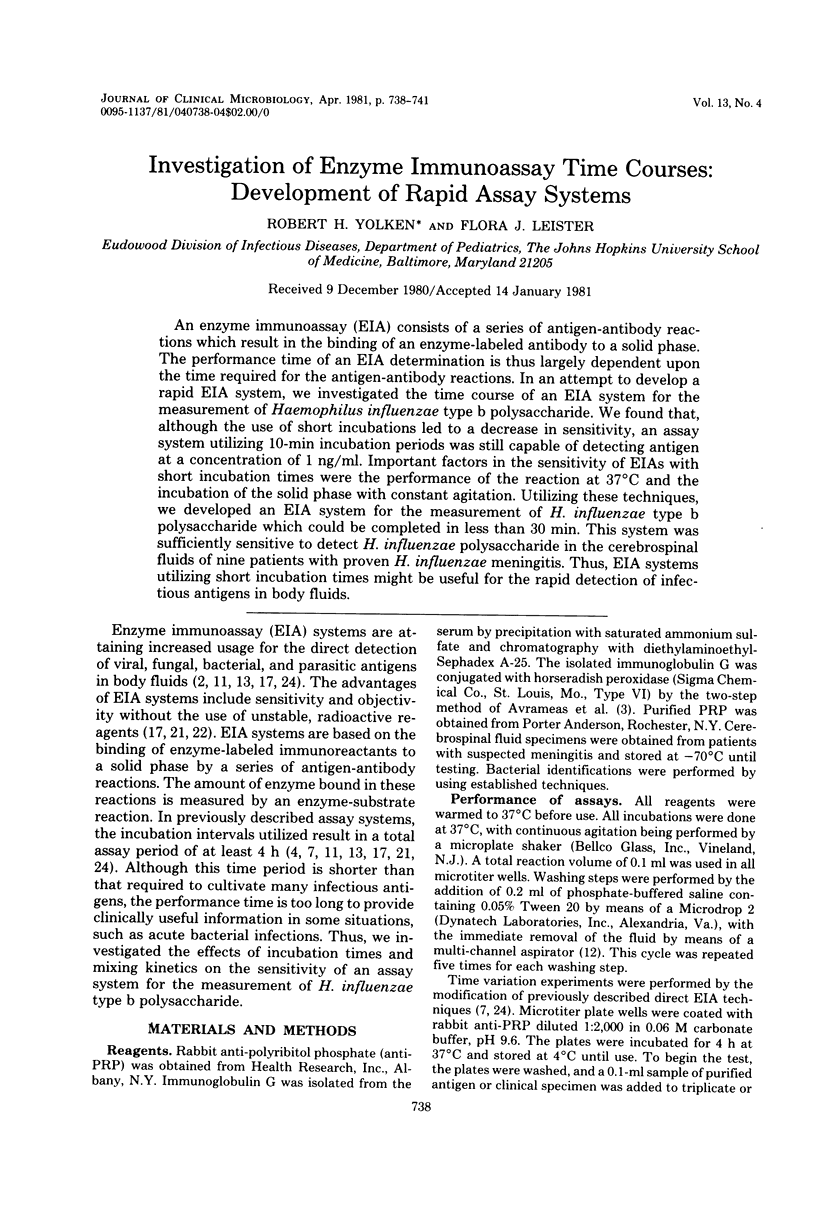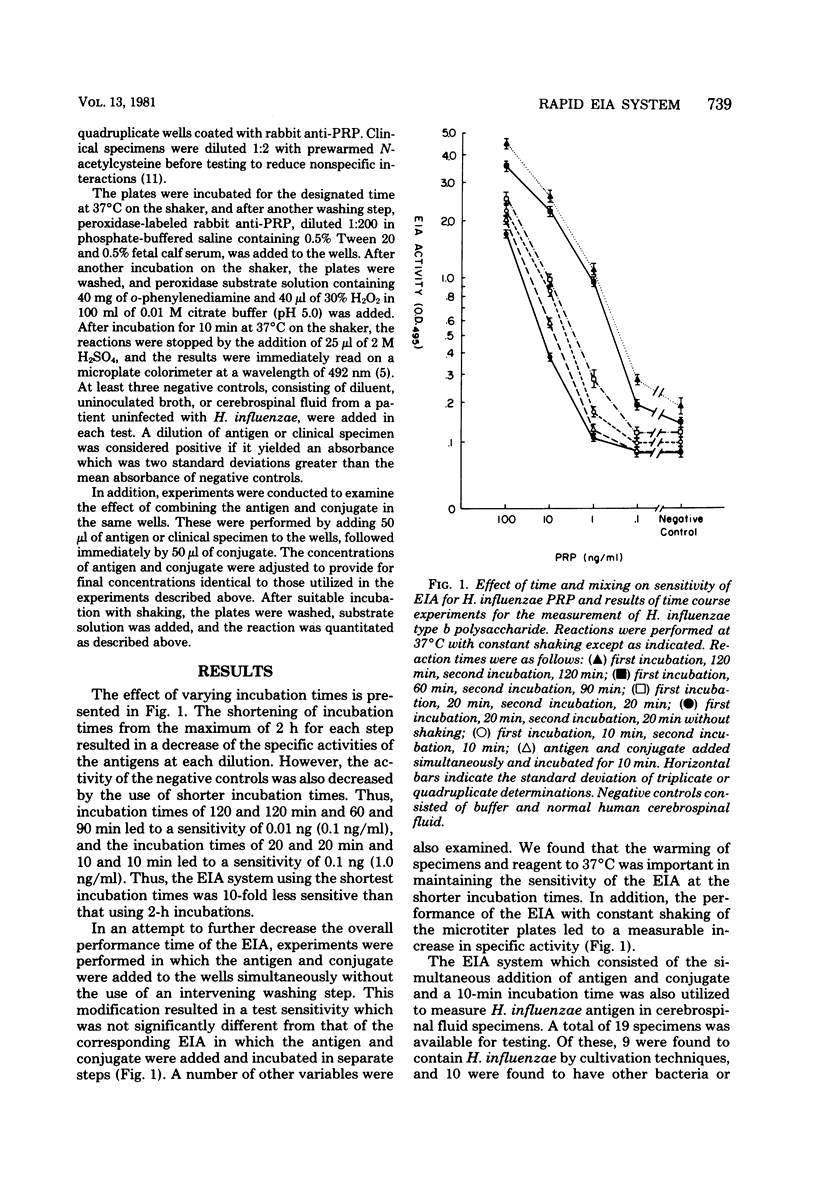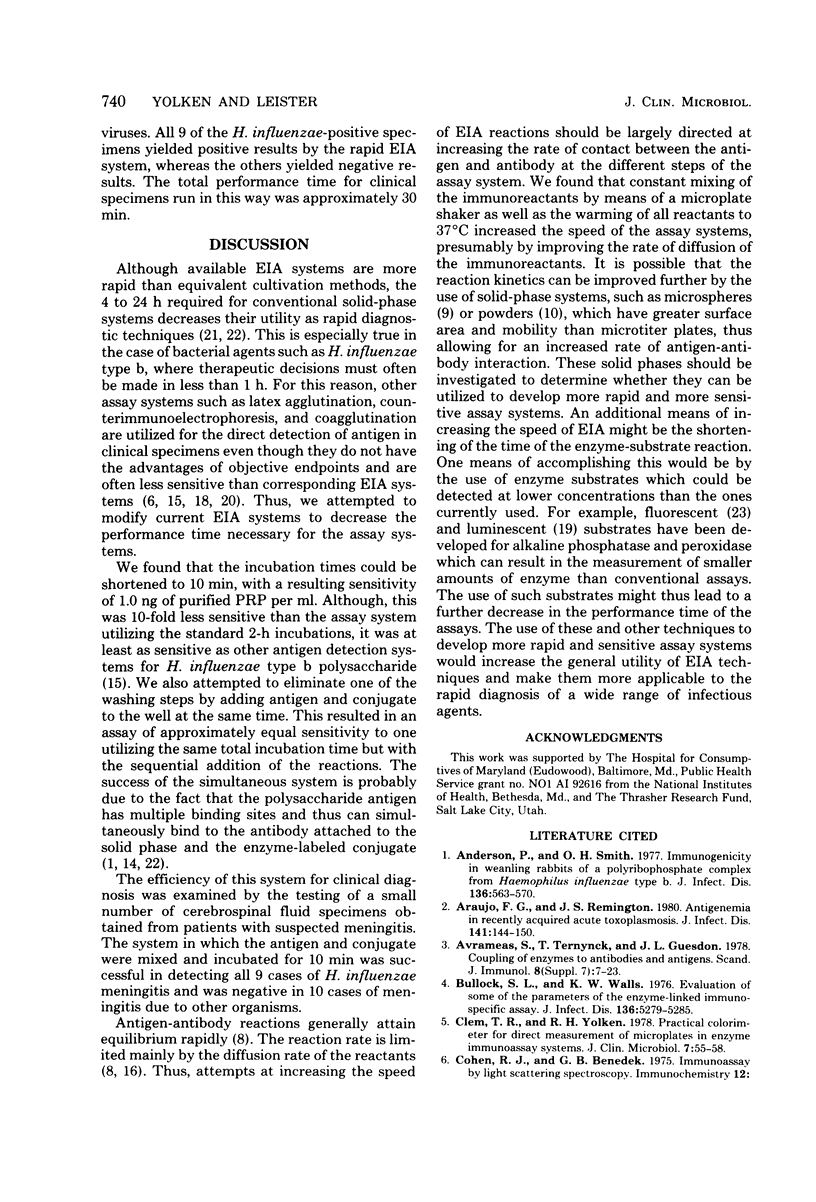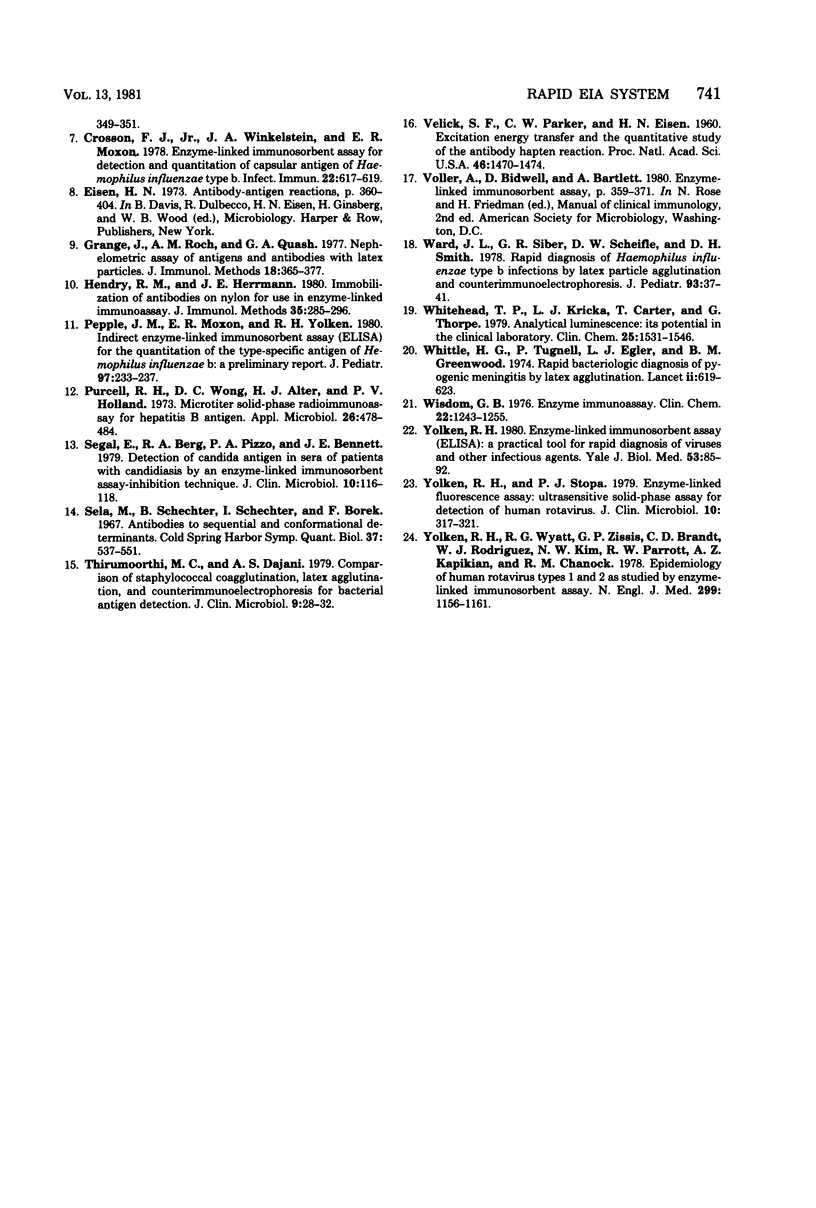Abstract
An enzyme immunoassay (EIA) consists of a series of antigen-antibody reactions which result in the binding of an enzyme-labeled antibody to a solid phase. The performance time of an EIA determination is thus largely dependent upon the time required for the antigen-antibody reactions. In an attempt to develop a rapid EIA system, we investigated the time course of an EIA system for the measurement of Haemophilus influenzae type b polysaccharide. We found that, although the use of short incubations led to a decrease in sensitivity, an assay system utilizing 10-min incubation periods was still capable of detecting antigen at a concentration of 1 ng/ml. Important factors in the sensitivity of EIAs with short incubation times were the performance of the reaction at 37 degrees C and the incubation of the solid phase with constant agitation. Utilizing these techniques, we developed an EIA system for the measurement of H. influenzae type b polysaccharide which could be completed in less than 30 min. This system was sufficiently sensitive to detect H. influenzae polysaccharide in the cerebrospinal fluids of nine patients with proven H. influenzae meningitis. Thus, EIA systems utilizing short incubation times might be useful for the rapid detection of infectious antigens in body fluids.
Full text
PDF



Selected References
These references are in PubMed. This may not be the complete list of references from this article.
- Araujo F. G., Remington J. S. Antigenemia in recently acquired acute toxoplasmosis. J Infect Dis. 1980 Feb;141(2):144–150. doi: 10.1093/infdis/141.2.144. [DOI] [PubMed] [Google Scholar]
- Clem T. R., Yolken R. H. Practical colorimeter for direct measurement of microplates in enzyme immunoassay systems. J Clin Microbiol. 1978 Jan;7(1):55–58. doi: 10.1128/jcm.7.1.55-58.1978. [DOI] [PMC free article] [PubMed] [Google Scholar]
- Crosson F. J., Jr, Winkelstein J. A., Moxon E. R. Enzyme-linked immunosorbent assay for detection and quantitation of capsular antigen of Haemophilus influenzae type b. Infect Immun. 1978 Nov;22(2):617–619. doi: 10.1128/iai.22.2.617-619.1978. [DOI] [PMC free article] [PubMed] [Google Scholar]
- Grange J., Roch A. M., Quash G. A. Nephelometric assay of antigens and antibodies with latex particles. J Immunol Methods. 1977;18(3-4):365–375. doi: 10.1016/0022-1759(77)90190-9. [DOI] [PubMed] [Google Scholar]
- Hendry R. M., Herrmann J. E. Immobilization of antibodies on nylon for use in enzyme-linked immunoassay. J Immunol Methods. 1980;35(3-4):285–296. doi: 10.1016/0022-1759(80)90255-0. [DOI] [PubMed] [Google Scholar]
- Pepple J., Moxon E. R., Yolken R. H. Indirect enzyme-linked immunosorbent assay for the quantitation of the type-specific antigen of Haemophilus influenzae b: a preliminary report. J Pediatr. 1980 Aug;97(2):233–237. doi: 10.1016/s0022-3476(80)80480-x. [DOI] [PubMed] [Google Scholar]
- Purcell R. H., Wong D. C., Alter H. J., Holland P. V. Microtiter solid-phase radioimmunoassay for hepatitis B antigen. Appl Microbiol. 1973 Oct;26(4):478–484. doi: 10.1128/am.26.4.478-484.1973. [DOI] [PMC free article] [PubMed] [Google Scholar]
- Segal E., Berg R. A., Pizzo P. A., Bennett J. E. Detection of Candida antigen in sera of patients with candidiasis by an enzyme-linked immunosorbent assay-inhibition technique. J Clin Microbiol. 1979 Jul;10(1):116–118. doi: 10.1128/jcm.10.1.116-118.1979. [DOI] [PMC free article] [PubMed] [Google Scholar]
- Thirumoorthi M. C., Dajani A. S. Comparison of staphylococcal coagglutination, latex agglutination, and counterimmunoelectrophoresis for bacterial antigen detection. J Clin Microbiol. 1979 Jan;9(1):28–32. doi: 10.1128/jcm.9.1.28-32.1979. [DOI] [PMC free article] [PubMed] [Google Scholar]
- Velick S. F., Parker C. W., Eisen H. N. EXCITATION ENERGY TRANSFER AND THE QUANTITATIVE STUDY OF THE ANTIBODY HAPTEN REACTION. Proc Natl Acad Sci U S A. 1960 Nov;46(11):1470–1482. doi: 10.1073/pnas.46.11.1470. [DOI] [PMC free article] [PubMed] [Google Scholar]
- Ward J. I., Siber G. R., Scheifele D. W., Smith D. H. Rapid diagnosis of Hemophilus influenzae type b infections by latex particle agglutination and counterimmunoelectrophoresis. J Pediatr. 1978 Jul;93(1):37–42. doi: 10.1016/s0022-3476(78)80596-4. [DOI] [PubMed] [Google Scholar]
- Whitehead T. P., Kricka L. J., Carter T. J., Thorpe G. H. Analytical luminescence: its potential in the clinical laboratory. Clin Chem. 1979 Sep;25(9):1531–1546. [PubMed] [Google Scholar]
- Whittle H. C., Tugwell P., Egler L. J., Greenwood B. M. Rapid bacteriological diagnosis of pyogenic meningitis by latex agglutination. Lancet. 1974 Sep 14;2(7881):619–621. doi: 10.1016/s0140-6736(74)91943-6. [DOI] [PubMed] [Google Scholar]
- Wisdom G. B. Enzyme-immunoassay. Clin Chem. 1976 Aug;22(8):1243–1255. [PubMed] [Google Scholar]
- Yolken R. H. Enzyme-linked immunosorbent assay (ELISA): a practical tool for rapid diagnosis of viruses and other infectious agents. Yale J Biol Med. 1980 Jan-Feb;53(1):85–92. [PMC free article] [PubMed] [Google Scholar]
- Yolken R. H., Stopa P. J. Enzyme-linked fluorescence assay: Ultrasensitive solid-phase assay for detection of human rotavirus. J Clin Microbiol. 1979 Sep;10(3):317–321. doi: 10.1128/jcm.10.3.317-321.1979. [DOI] [PMC free article] [PubMed] [Google Scholar]
- Yolken R. H., Wyatt R. G., Zissis G., Brandt C. D., Rodriguez W. J., Kim H. W., Parrott R. H., Urrutia J. J., Mata L., Greenberg H. B. Epidemiology of human rotavirus Types 1 and 2 as studied by enzyme-linked immunosorbent assay. N Engl J Med. 1978 Nov 23;299(21):1156–1161. doi: 10.1056/NEJM197811232992103. [DOI] [PubMed] [Google Scholar]


